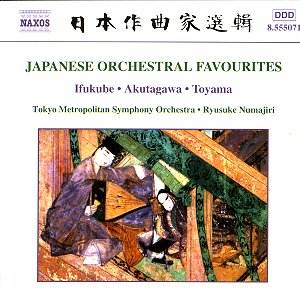Most pieces here will probably be as unfamiliar to
readers as they were to me, for very little Japanese music is known
in the West although some composers have had some popularity outside
Japan. I was thus quite surprised to read that Konoye’s arrangement
of old Japanese tunes Etenraku (1931) had been taken-up
by Stokowski and that Ifukube’s Japanese Rhapsody (1935)
had been admired by Roussel, Honegger and Sibelius.
So, let’s start at the beginning. Konoye, who was also
a conductor and had been a pupil of Vincent d’Indy in Paris, made his
arrangement of old Japanese gagaku tunes Etenraku
in 1931. The music, even in its Westernised garb, sounds quintessentially
Japanese. It is a very fine piece of orchestration and a quite attractive
work in its own right. Curiously, though I am sure that I have never
heard it before, it sounded quite familiar.
Ifukube may be a much better-known name though his
music must still be a terra incognita for many music lovers.
His Japanese Rhapsody of 1935 is a really beautiful work.
The titles of its two movements (Nocturne and Fêtes)
bring Debussy to mind, and the music certainly sounds impressionistic.
It is beautifully, often delicately scored and is as authentically Japanese
as Konoye’s arrangement, although it does not use any folk tunes at
all.
Koyama’s Kobiki-Uta, dating from 1957,
is a set of variations on a traditional work-song (actually a wood-cutter’s
song); and, at times, as at the very beginning of the piece, the music
imitates the sound of the wood-cutter’s saw. A colourful, worthwhile
novelty.
Akutagawa’s nondescript Music for Symphony Orchestra
completed in 1950 is the only work in this selection to have no particular
connection with Japan. The first part Andantino is some sort
of easy-going Nocturne whereas the second part Allegro is a rumbustious
Galop redolent of, say, Kabalevsky. A delightful, though somewhat
lighter piece.
Toyama’s Rhapsody for Orchestra (1960)
also uses a number of traditional tunes, all brilliantly scored. Another
very attractive lighter work.
Yoshimatsu, the youngest composer here, is probably
the best-known of all, since a number of his major orchestral works
have recently been recorded by Chandos. Though not extravagantly modern,
Yoshimatsu’s sound world exploits various resources of the modern symphony
orchestra. His beautifully atmospheric Threnody to Toki Op.12
dating from 1980 is modestly scored for piano and strings. The toki
is the Japanese crested ibis, an endangered species which the composer
thus sees as the symbol of natural beauty threatened by the modern world.
The music is delicately scored with many arresting string textures,
and vividly evokes the flight of the toki.
Excellent performances of these colourful and varied
works, fine recorded sound and informative notes. This is the first
instalment of a projected series of sixty CDs of Japanese music, and
it augurs well for what is to come.
Hubert Culot


